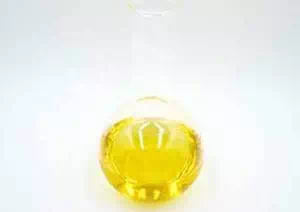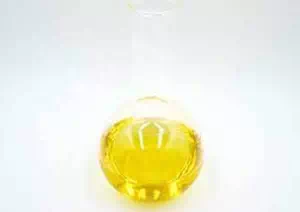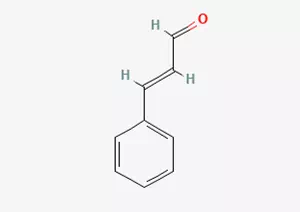All Categories



cinnamic aldehyde CAS 104-55-2, cinnamic aldehyde, CAS 104-55-2
Cinnamaldehyde, also known as β -benzo-acrolein or 3-phenyl-2-acrolein, is an aldehyde organic compound present in essential oils such as cinnamon oil, rose oil and patchouli oil. Its chemical name is triphenylacrolein, with the molecular formula C9H8O. Under normal pressure, its melting point is -8℃ and its boiling point is 253℃. It exists in liquid form.
CAS : 104-55-2
Formula : C9H8O
Mol. wt. : 132.16
EINECS : 203-213-9
Chemical Name | Cinnamic Aldehyde |
Other Name | Cinnamaldehyde; 3-PHENYLPROPENAL |
CAS | 104-55-2 |
EINECS | 203-213-9 |
Type | Food additives; Pharmaceutical raw materials; Organic raw materials; Feed additives; Flavors and fragrances; Plant extracts |
Molecular Formula | C9H8O |
Molecular Weight | 132.16 |

elting point | −9-−4 °C(lit.) |
Boiling point | 248 °C (lit.) |
density | 1.05 g/mL at 25 °C (lit.) |
vapor density | 4.6 (vs air) |
vapor pressure | <0.1 hPa (20 °C) |
refractive index | n20/D 1.622(lit.) |
Fp | 160 °F |
storage temp. | Store below +30°C. |
solubility | 1g/l soluble |
form | Liquid |
pka | 0[at 20 ℃] |
color | Clear yellow |
Specific Gravity | 1.05 |
Odor | Strong odor of cinnamon |
Odor Type | spicy |
Water Solubility | Slightly soluble |
Cinnamaldehyde has two isomers: cis and trans. Natural cinnamaldehyde has a trans structure. It not only has a rich and long-lasting aroma of cinnamon oil, but also possesses multiple properties such as antibacterial and antifungal, blood vessel dilation, and blood pressure reduction. Therefore, it is widely used in the fields of medicine, food industry, etc.
In the medical field, cinnamaldehyde has attracted much attention due to its effects of lowering blood sugar and blood lipids. Studies have shown that the intake of cinnamaldehyde can enhance the body's utilization of glucose and esters, thereby achieving the goals of lowering blood sugar and blood lipids. Specifically, after patients with type 2 diabetes took cinnamaldehyde, their fasting blood glucose, triglyceride and low-density lipoprotein levels decreased significantly. In addition, cinnamaldehyde can also be used in the treatment of anti-cellular fibrosis. Studies have found that cinnamaldehyde can inhibit the proliferation and hypertrophy of renal interstitial fibroblasts caused by high glucose, as well as the synthesis and secretion of interstitial collagen. Huang Jiangyan's experiments on rats induced by high glucose also demonstrated that cinnamaldehyde can reduce the proliferation of cardiac fibroblasts in rats and inhibit the synthesis and secretion of collagen between cells. The research by CAI Leiqin et al. further found that cinnamaldehyde can specifically activate the factor pathway related to nuclear factor E-2, thereby promoting wound healing in diabetic mice.
In addition to its application in the medical field, cinnamaldehyde also plays an important role in other aspects. For instance, studies have shown that cinnamaldehyde resists peptic ulcers by inhibiting the erosion of gastric mucosa by pepsin and increasing the blood flow to the gastric mucosa. At the same time, it can also slightly stimulate the gastrointestinal tract, promote the secretion of saliva and gastric juice, enhance digestive function, stimulate appetite and relieve gastrointestinal discomfort. In addition, cinnamaldehyde can also relieve smooth muscle spasms and alleviate spasmodic pain in the intestines.
Overall, cinnamaldehyde, as an organic compound with multiple biological activities, has broad application prospects in various fields such as medicine and food. However, when in use, relevant regulations and standards should be strictly followed to ensure its safety and effectiveness are guaranteed.

In today's rich and diverse fields of medicine and spices, cinnamaldehyde undoubtedly holds a crucial position and can be regarded as one of the important raw materials for medicine. In the field of medicine, cinnamaldehyde has a very wide range of applications, especially in the preparation of topical drugs and various synthetic drugs, where it plays an indispensable role.
From the perspective of its medicinal effects, cinnamaldehyde has many remarkable characteristics. It can effectively promote blood circulation in the human body, as if injecting a vitality into the internal "transportation network" of the body, allowing blood to flow more smoothly in the blood vessels and delivering sufficient nutrients and oxygen to various organs and tissues. At the same time, it also has the magical effect of warming the skin. When applied to the skin surface, it can give people a gentle and comfortable feeling, just like covering the skin with a warm coat on a cold winter day. Not only that, cinnamaldehyde can also firm the skin tissue, making the skin more elastic and lustrous, as if injecting new vitality and vigor into the skin.
When used externally, cinnamaldehyde can be massaged to make the limbs and body feel extremely comfortable. This comfortable experience is not only due to its nourishing effect on the skin, but also because it can fully improve the phenomenon of water retention. Imagine that as the excessive and retained water inside the body is gradually discharged and excreted, the burden on the body is also reduced, and the whole person will feel relaxed and at ease. Moreover, cinnamaldehyde has a strong lipid-lowering effect, acting like an efficient "fat cleaner" that can help the body break down and metabolize excess fat, which is of positive significance for maintaining a good figure and health.
Cinnamaldehyde performs particularly well in treating skin problems. It is a powerful weapon for softening and removing skin scars and fibroids. It can penetrate deep into the skin and effectively repair and eliminate those stubborn scars and fibroids. At the same time, it also has the function of dispelling congestion, just like opening up an unobstructed channel for the circulation of qi and blood inside the body, allowing all parts of the body to be fully nourished and regulated.
In addition to the above-mentioned effects, cinnamaldehyde also has antithrombin effects and can play an important physiological regulatory role at critical moments. In addition, it has multiple functions such as sedation, pain relief, antipyretic and anticonvulsant effects. It is like an all-round "guardian angel", providing timely comfort and relief when various discomforts occur in the body. It is worth mentioning that cinnamaldehyde also has a significant inhibitory effect on mold, effectively preventing the growth and infection of mold and safeguarding the health of the body.
In the field of spices, cinnamaldehyde also holds a significant position and is one of the important spices. In daily life, cinnamaldehyde is often added to the soap fragrances we commonly see. It can add a unique aroma to soap, allowing people to enjoy a pleasant scent while using soap to clean their bodies. Not only that, cinnamaldehyde is also a key component in the preparation of various essences, such as jasmine, jasmine flower, lily of the valley, rose essences, etc. It can simulate the fragrant scents of these flowers, endowing various perfumes, skin care products and other items with charming fragrances, allowing people to enjoy the beauty while also experiencing the fragrance of nature.
Cinnamaldehyde also has extensive applications in the food industry. It can be used for the preservation of fruits and other foods, extending the shelf life of food and ensuring its freshness and safety. The latest research shows that adding cinnamaldehyde to chewing gum can endow it with the dual functions of oral sterilization and deodorization. When we chew gum containing cinnamaldehyde, it not only freshens our breath but also effectively kills bacteria in the mouth, preventing the occurrence of oral diseases and adding a powerful protective barrier to our oral health.
However, it should be noted that although cinnamaldehyde has many advantages, it also has a certain degree of irritation. It has a very strong bactericidal effect, and its bactericidal ability is no less than that of carvacrol. This powerful bactericidal ability may cause certain harm to the human body in some cases. For instance, direct use of cinnamaldehyde can seriously damage the skin surface and bring a strong burning sensation to the skin. Therefore, to ensure safe use, everyone must dilute it when using it and keep its concentration within an appropriate range. Only in this way can its advantages be fully exerted and unnecessary harm to the body be avoided.
In addition to the effects mentioned above, cinnamaldehyde also has many other properties. It has the ability to resist viruses and reduce inflammation, capable of withstanding the invasion of viruses and alleviating the body's inflammatory response. Just like a "guardian" of the body, it always guards our health. At the same time, it can also enhance the body's immunity and strengthen the body's self-defense ability, enabling us to deal with various disease threats more calmly.
Cinnamaldehyde also has an outstanding performance in promoting physical functions. It can promote blood circulation and ensure that all parts of the body receive sufficient blood supply. It can also warm the body and dispel wind, helping us resist cold and external pathogenic factors. In addition, cinnamaldehyde can also relieve flatulence and aid digestion. It has a good effect on alleviating gastrointestinal discomfort and promoting the digestion and absorption of food. Cinnamaldehyde also plays a positive role in blood sugar control. It can alleviate the discomfort caused by congenital or acquired diabetes and help patients better control their blood sugar levels.
Aromatic aldehydes, as a form of cinnamaldehyde, are powerful antioxidants. It can support the health of cells, the liver, the brain and the kidneys, providing a strong guarantee for the normal operation of these important organs. At the same time, it can also promote the functions of the digestive, nervous and circulatory systems, enabling the various systems in our body to work more harmoniously and orderly, and maintaining the healthy balance of the body.
In medical research, cinnamaldehyde has also been found to have the effects of lowering blood sugar and blood lipids, which brings new hope for the treatment of type 2 diabetes. When the human body takes in cinnamaldehyde, it can enhance the body's utilization efficiency of glucose and esters, just like installing an efficient "metabolic engine" for the body, enabling the body to better process glucose and fat in the blood, thereby achieving the purpose of lowering blood sugar and blood lipids. A large number of studies have shown that after taking cinnamaldehyde, the fasting blood glucose, triglyceride and low-density lipoprotein levels of patients with type 2 diabetes will be significantly reduced, which undoubtedly brings good news to diabetic patients.
In addition, cinnamaldehyde has also shown great potential in the treatment of anti-cellular fibrosis. Studies have found that cinnamaldehyde can inhibit the proliferation and hypertrophy of renal interstitial fibroblasts caused by high glucose, as well as the synthesis and secretion of interstitial collagen. This means that cinnamaldehyde is expected to become a new drug for treating diseases related to cellular fibrosis, bringing new treatment options and hope to many patients.
* Prompt reply and 24 hours online, professional team to provide best price and high quality product.
* Sample testing support.
* Every batch of products will be tested to ensureits quality.
*The packing also can be according the customers` requirment.
*Any inquiries will be replied within 24 hours.
*we provide Commerical Invoice, Packing List, Bill of loading, COA , Health certificate and Origin certificate. If your markets have any special requirements, let us know.